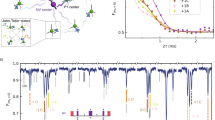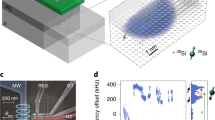Abstract
Electron and nuclear spins associated with point defects in insulators are promising systems for solid-state quantum technology1,2,3. The electron spin is usually used for readout and addressing, and nuclear spins are used as exquisite quantum bits4,5 and memory systems3,6. With these systems, single-shot readout of single nuclear spins5,7 as well as entanglement4,8,9, aided by the electron spin, have been shown. Although the electron spin in this example is essential for readout, it usually limits the nuclear spin coherence10, leading to a quest for defects with spin-free ground states9,11. Here, we isolate a hitherto unidentified defect in diamond and use it at room temperature to demonstrate optical spin polarization and readout with exceptionally high contrast (up to 45%), coherent manipulation of an individual excited triplet state spin, and coherent nuclear spin manipulation using the triplet electron spin as a metastable ancilla. We demonstrate nuclear magnetic resonance and Rabi oscillations of the uncoupled nuclear spin in the spin-free electronic ground state. Our study demonstrates that nuclei coupled to single metastable electron spins are useful quantum systems with long memory times, in spite of electronic relaxation processes.
This is a preview of subscription content, access via your institution
Access options
Subscribe to this journal
Receive 12 print issues and online access
$259.00 per year
only $21.58 per issue
Buy this article
- Purchase on Springer Link
- Instant access to full article PDF
Prices may be subject to local taxes which are calculated during checkout





Similar content being viewed by others
References
Ladd, T. D. et al. Quantum computers. Nature 464, 45–53 (2010).
Koehl, W. F., Buckley, B. B., Heremans, F. J., Calusine, G. & Awschalom, D. D. Room temperature coherent control of defect spin qubits in silicon carbide. Nature 479, 84–87 (2011).
Morton, J. J. L. et al. Solid-state quantum memory using the 31P nuclear spin. Nature 455, 1085–1088 (2008).
Dutt, M. V. G. et al. Quantum register based on individual electronic and nuclear spin qubits in diamond. Science 316, 1312–1316 (2007).
Neumann, P. et al. Single-shot readout of a single nuclear spin. Science 329, 542–544 (2010).
Steger, M. et al. Quantum information storage for over 180 s using donor spins in a 28Si ‘semiconductor vacuum'. Science 336, 1280–1283 (2012).
Pla, J. J. et al. High-fidelity readout and control of a nuclear spin qubit in silicon. Nature 496, 334–338 (2013).
Neumann, P. et al. Multipartite entanglement among single spins in diamond. Science 320, 1326–1329 (2008).
Filidou, V. et al. Ultrafast entangling gates between nuclear spins using photoexcited triplet states. Nature Phys. 8, 1–5 (2012).
Maurer, P. C. et al. Room-temperature quantum bit memory exceeding one second. Science 336, 1283–1286 (2012).
Akhtar, W. et al. Coherent storage of photoexcited triplet states using 29Si nuclear spins in silicon. Phys. Rev. Lett. 108, 1–5 (2012).
Brennecke, F., Ritter, S., Donner, T. & Esslinger, T. Cavity optomechanics with a Bose–Einstein condensate. Science 322, 235–238 (2008).
Brown, K. R. et al. Coupled quantized mechanical oscillators. Nature 471, 196–199 (2011).
Zhu, X. et al. Coherent coupling of a superconducting flux qubit to an electron spin ensemble in diamond. Nature 478, 221–224 (2011).
Kubo, Y. et al. Strong coupling of a spin ensemble to a superconducting resonator. Phys. Rev. Lett. 105, 1–4 (2010).
Babinec, T. M. et al. A diamond nanowire single-photon source. Nature Nanotech. 5, 195–199 (2010).
Epstein, R. J., Mendoza, F. M., Kato, Y. K. & Awschalom, D. D. Anisotropic interactions of a single spin and dark-spin spectroscopy in diamond. Nature Phys. 1, 94–98 (2005).
Kurtsiefer, C., Mayer, S., Zarda, P. & Weinfurter, H. Stable solid-state source of single photons. Phys. Rev. Lett. 85, 290–293 (2000).
Zaitsev, A. M. Optical Properties of Diamond: A Data Handbook (Springer, 2001).
Carrington, A. & McLachlan, A. D. Introduction to Magnetic Resonance with Applications to Chemistry and Chemical Physics (Harper & Row, 1967).
Jacques, V. et al. Dynamic polarization of single nuclear spins by optical pumping of nitrogen-vacancy color centers in diamond at room temperature. Phys. Rev. Lett. 102, 7–10 (2009).
Colpa, J. P. & Stehlik, D. Optical nuclear polarization as a consequence of the non-crossing rule (level-anti-crossing). Chem. Phys. 21, 273–288 (1977).
Hoch, M. & Reynhardt, E. Nuclear spin-lattice relaxation of dilute spins in semiconducting diamond. Phys. Rev. B 37, 9222–9226 (1988).
Burum, D., Linder, M. & Ernst, R. Low-power multipulse line narrowing in solid-state NMR. J. Magn. Reson. (1969) 44, 173–188 (1981).
Bielecki, A., Kolbert, A. C. & Levitt, M. H. Frequency-switched pulse sequences: homonuclear decoupling and dilute spin NMR in solids. Chem. Phys. Lett. 155, 341–346 (1989).
Rhim, W-K. Enhanced resolution for solid state NMR. J. Chem. Phys. 58, 1772 (1973).
Acknowledgements
The authors acknowledge support from the DFG (Forschergruppe 1493 and SFB/TR21) as well as the EU (ERC grant SQUTEC and FP7 grants DIAMANT and QINVC). B.H. acknowledges support from HQOC. The authors thank M. Sellars, P. Hemmer, P. Neumann, R. Kolesov, R. Stöhr and C. Burk for discussions.
Author information
Authors and Affiliations
Contributions
S.L., H.F. and J.W. designed the experiments. S.L., M.W., T.R., T.B., S.Y., M.E., P.S. and H.F. performed the experiments. S.L., M.W., M.D. and H.F. analysed the data. B.H. and M.L. fabricated the nanopillars. M.D., Z.B., A.G. and N.M. provided theoretical support. All authors discussed the data and commented on the manuscript. S.L., M.D., H.F. and J.W. wrote the paper.
Corresponding authors
Ethics declarations
Competing interests
The authors declare no competing financial interests.
Supplementary information
Supplementary information
Supplementary Information (PDF 3757 kb)
Rights and permissions
About this article
Cite this article
Lee, SY., Widmann, M., Rendler, T. et al. Readout and control of a single nuclear spin with a metastable electron spin ancilla. Nature Nanotech 8, 487–492 (2013). https://doi.org/10.1038/nnano.2013.104
Received:
Accepted:
Published:
Issue Date:
DOI: https://doi.org/10.1038/nnano.2013.104
This article is cited by
-
Carbon defect qubit in two-dimensional WS2
Nature Communications (2022)
-
An L-band emitter with quantum memory in silicon
npj Computational Materials (2022)
-
Transition metal impurities in silicon: computational search for a semiconductor qubit
npj Computational Materials (2022)
-
TR12 centers in diamond as a room temperature atomic scale vector magnetometer
npj Quantum Information (2022)
-
Single artificial atoms in silicon emitting at telecom wavelengths
Nature Electronics (2020)



